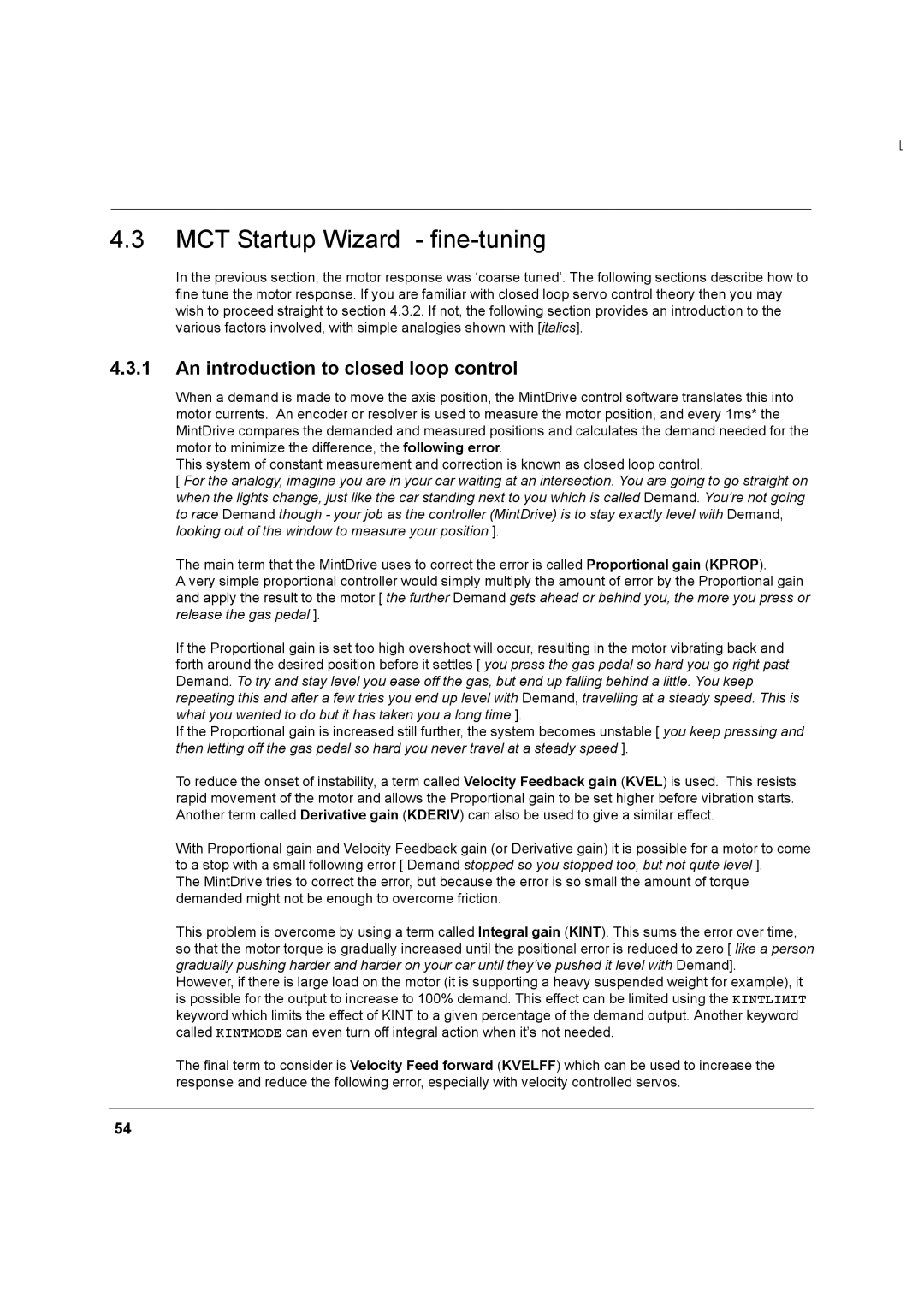
4.3MCT Startup Wizard - fine-tuning
In the previous section, the motor response was ‘coarse tuned’. The following sections describe how to fine tune the motor response. If you are familiar with closed loop servo control theory then you may wish to proceed straight to section 4.3.2. If not, the following section provides an introduction to the various factors involved, with simple analogies shown with [italics].
4.3.1An introduction to closed loop control
When a demand is made to move the axis position, the MintDrive control software translates this into motor currents. An encoder or resolver is used to measure the motor position, and every 1ms* the MintDrive compares the demanded and measured positions and calculates the demand needed for the motor to minimize the difference, the following error.
This system of constant measurement and correction is known as closed loop control.
[ For the analogy, imagine you are in your car waiting at an intersection. You are going to go straight on when the lights change, just like the car standing next to you which is called Demand. You’re not going to race Demand though - your job as the controller (MintDrive) is to stay exactly level with Demand, looking out of the window to measure your position ].
The main term that the MintDrive uses to correct the error is called Proportional gain (KPROP).
A very simple proportional controller would simply multiply the amount of error by the Proportional gain and apply the result to the motor [ the further Demand gets ahead or behind you, the more you press or release the gas pedal ].
If the Proportional gain is set too high overshoot will occur, resulting in the motor vibrating back and forth around the desired position before it settles [ you press the gas pedal so hard you go right past Demand. To try and stay level you ease off the gas, but end up falling behind a little. You keep repeating this and after a few tries you end up level with Demand, travelling at a steady speed. This is what you wanted to do but it has taken you a long time ].
If the Proportional gain is increased still further, the system becomes unstable [ you keep pressing and then letting off the gas pedal so hard you never travel at a steady speed ].
To reduce the onset of instability, a term called Velocity Feedback gain (KVEL) is used. This resists rapid movement of the motor and allows the Proportional gain to be set higher before vibration starts. Another term called Derivative gain (KDERIV) can also be used to give a similar effect.
With Proportional gain and Velocity Feedback gain (or Derivative gain) it is possible for a motor to come to a stop with a small following error [ Demand stopped so you stopped too, but not quite level ].
The MintDrive tries to correct the error, but because the error is so small the amount of torque demanded might not be enough to overcome friction.
This problem is overcome by using a term called Integral gain (KINT). This sums the error over time, so that the motor torque is gradually increased until the positional error is reduced to zero [ like a person gradually pushing harder and harder on your car until they’ve pushed it level with Demand].
However, if there is large load on the motor (it is supporting a heavy suspended weight for example), it is possible for the output to increase to 100% demand. This effect can be limited using the KINTLIMIT keyword which limits the effect of KINT to a given percentage of the demand output. Another keyword called KINTMODE can even turn off integral action when it’s not needed.
The final term to consider is Velocity Feed forward (KVELFF) which can be used to increase the response and reduce the following error, especially with velocity controlled servos.
54
